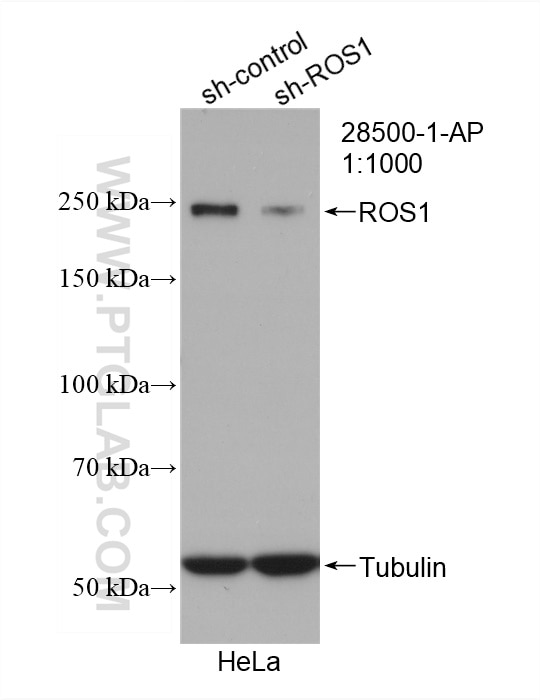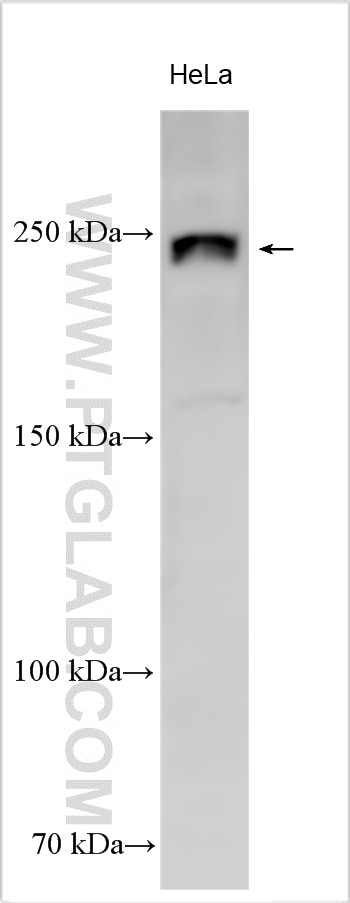- Phare
- Validé par KD/KO
Anticorps Polyclonal de lapin anti-ROS1
ROS1 Polyclonal Antibody for WB, ELISA
Hôte / Isotype
Lapin / IgG
Réactivité testée
Humain
Applications
WB, ELISA
Conjugaison
Non conjugué
N° de cat : 28500-1-AP
Synonymes
Galerie de données de validation
Applications testées
| Résultats positifs en WB | cellules HeLa, |
Dilution recommandée
| Application | Dilution |
|---|---|
| Western Blot (WB) | WB : 1:500-1:2000 |
| It is recommended that this reagent should be titrated in each testing system to obtain optimal results. | |
| Sample-dependent, check data in validation data gallery | |
Informations sur le produit
28500-1-AP cible ROS1 dans les applications de WB, ELISA et montre une réactivité avec des échantillons Humain
| Réactivité | Humain |
| Hôte / Isotype | Lapin / IgG |
| Clonalité | Polyclonal |
| Type | Anticorps |
| Immunogène | ROS1 Protéine recombinante Ag28943 |
| Nom complet | c-ros oncogene 1 , receptor tyrosine kinase |
| Masse moléculaire calculée | 264 kDa |
| Poids moléculaire observé | 250 kDa |
| Numéro d’acquisition GenBank | NM_002944 |
| Symbole du gène | ROS1 |
| Identification du gène (NCBI) | 6098 |
| Conjugaison | Non conjugué |
| Forme | Liquide |
| Méthode de purification | Purification par affinité contre l'antigène |
| Tampon de stockage | PBS with 0.02% sodium azide and 50% glycerol |
| Conditions de stockage | Stocker à -20°C. Stable pendant un an après l'expédition. L'aliquotage n'est pas nécessaire pour le stockage à -20oC Les 20ul contiennent 0,1% de BSA. |
Informations générales
ROS1, an orphan receptor tyrosine kinase of the insulin receptor family, was initially identified as a homolog of v-ros from the UR2 sarcoma virus (PMID: 3023956). It's reported that rearrangements of the ROS1 gene occur in many cancers. The first oncogenic fusion of ROS1, FIG-ROS1, was initially identified by research studies in glioblastoma (PMID: 12661006), and subsequent studies have found this fusion in cholangiocarcinoma, ovarian cancer and non-small cell lung cancer (NSCLC) (PMID: 21253578, 22163003, 22661537). Additional oncogenic ROS1 fusion proteins have been found in NSCLC (at a frequency of 1-2%), including FIG, CD74, SLC34A2 and SDC4, and the list is growing. CD74-ROS1 is the most frequently detected ROS1 fusion in this group of patients. With all of the known fusion genes, the ROS1 kinase domain is fully retained and the ROS1 junction point at the messenger RNA (mRNA) level invariably occurs at the 5' end of exons 32, 34, 35 or 36 (PMID: 27535289). The molecular mass of some ROS1 fusion proteins are detected as follows: FIG-ROS1 (110 kDa), SLC34A2-ROS1 (85/70/59 kDa), CD74-ROS1 (80 kDa), and SDC4-ROS1 (75 kDa). (PMID: 22661537, 22659450)
Protocole
| Product Specific Protocols | |
|---|---|
| WB protocol for ROS1 antibody 28500-1-AP | Download protocol |
| Standard Protocols | |
|---|---|
| Click here to view our Standard Protocols |



